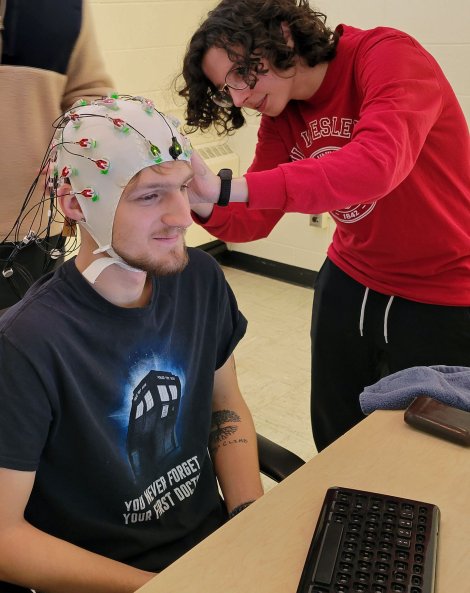
Cognition and Affect
Ohio Wesleyan Student Explores How People Understand and Act on Information
Name: Chandler Carr ’24
Hometown: Washington Court House, Ohio
Majors: Biology and Neuroscience
High school: Washington High School
OWU Connection Experience: Independent Study project, “Neural Correlate of Cognition and Affect,” overseen by Kira Bailey, Ph.D., associate professor of Psychology and Neuroscience. In conjunction with related research, Carr will be presenting preliminary results in April at the Midwestern Psychological Association conference in Chicago.
Relational Research
“Our study is examining the interconnected relationship of cognition (acquiring knowledge and understanding) and emotion. I like to refer to it as the relationship between cognitive control and emotional robustness. The participants perform two tasks where response time and accuracy are key.
“One of the tasks has participants look at a color word, such as ‘green,’ that will have a certain font color, let's say red. The participant is asked to input a response that corresponds to the font color, but will often get tripped up by the word itself and slow down. This is an example of how reading is an automatic process we don’t have control over. When we see a word, we read it. Quicker response times can indicate a stronger control over one’s automatic responses.”
Adding Emotion
“We are also examining participant’s reaction times when the word they are reading is emotionally meaningful. There is evidence to suggest that automatic reading of emotional words can slow our reaction times, especially when that emotional word is particularly personal to the participant.
“I actually designed the emotion task myself in an attempt to examine a participant’s ‘emotional granularity.’ The idea is that people have emotional vocabularies of varying sizes, and those with larger vocabularies have an easier time handling their emotions because they can describe emotional events in more granular, more detailed, ways.
“The method to probe this idea is in the task’s structure. Half of the words have a ‘high frequency’ in the population, meaning they are spoken often, and half of the words have a ‘low frequency,’ as they are spoken very little. We hope to find individual differences in participant’s reaction times to emotional words relative to that word’s frequency in the population. In other words, do people with large emotional vocabularies use rarer emotional words?
“We will also record brain data while participants perform the tasks. Cognitive control in both tasks will be assessed by accuracy, response time, and ERP components associated with the ability to detect and resolve within-trial conflict.” (ERPs, or event-related brain potentials, are specific patterns of electrical activities that occur in the brain during cognitive acts, helping researchers to better understand memory-related issues.)
Lessons Learned
“I have so far learned how to design and operate an EEG (electroencephalogram) study. The experience has been both an enhancement of my classroom knowledge, from the Affective Neuroscience course and others, and a benefit to my future plans. I spend about 16 hours a week in the lab for data collection and analysis.
“I have also gained experience at running a lab. While the study design is between Dr. Bailey and me, data collection, processing, and analysis is the result of my work and my many great research assistants. I have had to quickly learn how to handle and guide the lab when needed, which has been a rewarding experience.”
Memorable Moment
“Collection of brain activity can be a tricky process with some funny defects in the data. One funny example was a time the cap was picking up electrical activity that the participant was blinking, which is a normal artifact in the data, but this time the spikes were half the size of the screen. Turns out the subject was wearing contacts, causing larger electrical friction that the electrodes picked up on.”
My Plans after Graduation
“I plan to get a doctorate in Evolutionary Biology with a desire to study avian behavior. I am also interested in using my Neuroscience education to study the neural mechanisms of heterospecific interactions.
